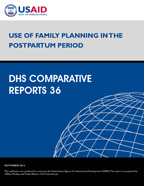- PUBLICATIONS
- JOURNAL ARTICLES
- ACCESS PUBLICATIONS
Publications Summary
- Document Type
- Comparative Reports
- Publication Topic(s)
- Family Planning, Maternal Health
- Language
- English
- Recommended Citation
- Winfrey, William and Kshitiz Rakesh. 2014. Use of Family Planning in the Postpartum Period. DHS Comparative Reports No. 36. Rockville, Maryland, USA: ICF International.
- Download Citation
- RIS format / Text format / Endnote format
- Publication Date
- September 2014
- Publication ID
- CR36
